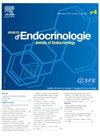Impact of therapeutic doses of prednisolone and other glucocorticoids on insulin secretion from human islets
IF 2.9
3区 医学
Q3 ENDOCRINOLOGY & METABOLISM
引用次数: 0
Abstract
Introduction
Glucocorticoid-induced diabetes (GCID) is a prevalent health issue, generally attributed to insulin resistance. High doses of dexamethasone (DEX) are known to inhibit glucose-stimulated insulin secretion (GSIS), but the effects of lower doses, commonly used in chronic therapy, and equipotent doses of other glucocorticoids (GCs) such as hydrocortisone (HC) and prednisone (PRED) remain underexplored. This study aimed to investigate these effects in vitro, and explore variations between patients.
Materials and methods
Dynamic perifusion assays were conducted on human islets to evaluate the impact of different GCs on GSIS. The islets were treated for 24 h with 250 nM PRED and other GCs at equipotent anti-inflammatory doses (HC: 1 μM; DEX: 38 nM).
Results
In 11 human islet donor preparations, 250 nM PRED, corresponding to a clinical oral dose of 5 mg/day, significantly inhibited the first and second phase of GSIS: area under the curve (AUC) decreased by 32.3% (P < 0.001), first phase by 41.5% (P < 0.001), and second phase by 38.4% (P < 0.001). Despite interindividual differences in GSIS response to PRED, no significant differences were observed according to body mass index, gender or age. Comparing the effects of GCs at equipotent anti-inflammatory doses, DEX had a more pronounced inhibitory effect on GSIS than HC or PRED.
Conclusions
In vitro, low-dose PRED treatment significantly impacted GSIS. DEX had a more unfavorable impact on GSIS than HC or PRED, indicating that metabolic effects do not align with anti-inflammatory potency.
强的松龙和其他糖皮质激素治疗剂量对胰岛胰岛素分泌的影响。
糖皮质激素诱导的糖尿病(GCID)是一种普遍的健康问题,通常归因于胰岛素抵抗。已知高剂量地塞米松(DEX)可抑制葡萄糖刺激胰岛素分泌(GSIS),但低剂量(通常用于慢性治疗)和同等剂量的其他糖皮质激素(GCs),如氢化可的松(HC)和泼尼松(PRED)的作用仍未得到充分研究。本研究旨在研究这些体外效应,并探讨患者之间的差异。材料与方法:采用人胰岛动态浸润试验,评价不同gc对GSIS的影响。用250 nM PRED和其他GCs等效抗炎剂量(HC: 1µM;DEX: 38 nM)。结果:在11种人胰岛供体制剂中,250 nM PRED(相当于临床口服剂量5mg/d)可显著抑制第一、二期GSIS:曲线下面积(AUC)下降32.3% (p < 0.001),一期下降41.5% (p < 0.001),二期下降38.4% (p < 0.001)。尽管GSIS对PRED的反应存在个体差异,但根据体重指数、性别或年龄,没有观察到显著差异。比较GCs在等效抗炎剂量下的作用,DEX对GSIS的抑制作用比HC或PRED更明显。结论:体外低剂量PRED治疗显著影响GSIS。DEX对GSIS的不利影响大于HC或PRED,表明代谢作用与抗炎效力不一致。
本文章由计算机程序翻译,如有差异,请以英文原文为准。
求助全文
约1分钟内获得全文
求助全文
来源期刊

Annales d'endocrinologie
医学-内分泌学与代谢
CiteScore
4.40
自引率
6.50%
发文量
311
审稿时长
50 days
期刊介绍:
The Annales d''Endocrinologie, mouthpiece of the French Society of Endocrinology (SFE), publishes reviews, articles and case reports coming from clinical, therapeutic and fundamental research in endocrinology and metabolic diseases. Every year, it carries a position paper by a work-group of French-language endocrinologists, on an endocrine pathology chosen by the Society''s Scientific Committee. The journal is also the organ of the Society''s annual Congress, publishing a summary of the symposia, presentations and posters. "Les Must de l''Endocrinologie" is a special booklet brought out for the Congress, with summary articles that are always very well received. And finally, we publish the high-level instructional courses delivered during the Henri-Pierre Klotz International Endocrinology Days. The Annales is a window on the world, keeping alert clinicians up to date on what is going on in diagnosis and treatment in all the areas of our specialty.
 求助内容:
求助内容: 应助结果提醒方式:
应助结果提醒方式:


